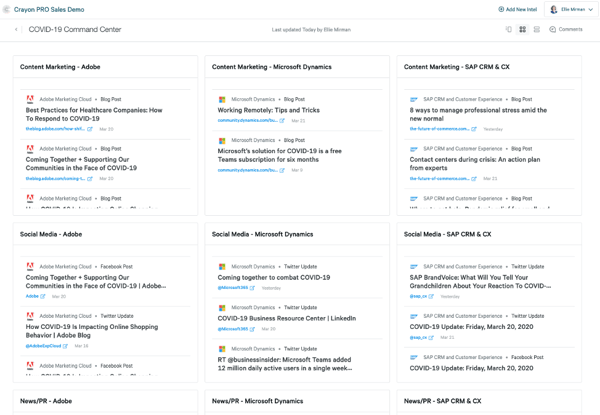When a global market event takes hold and catches everyone by surprise, executives are left scrambling to get a handle on how their industry is responding. With the latest crisis, our customer success managers teamed up with our customers’ market and competitive intelligence professionals to build executive dashboards to get a handle on their industry’s response. If you’re struggling to figure out how to communicate what’s important about this event to your executive team, and ultimately figure out your own strategic response, here are lessons learned from working with Fortune 500 companies doing exactly that.
Building a Command Center
When events are changing literally every day, it’s important to have a centralized place to surface updates from your industry and summarize them in a singular view. This command center should combine everything that’s being shared by everyone in your industry around the event:
- Content Marketing: How are your competitors addressing this event through their content marketing channels?
- Messaging & Positioning: Are your competitors creating new webpages in response to the event? Are there any site-wide banners or other messages addressing the event?
- News & PR: How is the world talking about what competitors are doing amid the event? Are your competitors putting out press releases?
- Social Media: How are competitors responding and interacting directly with the world in conversations about this event?
- Team Trends: Have there been any layoffs or changes in hiring? How are employees talking about competitors online?
- Pricing & Offers: Are your competitors changing their pricing in response to the market shift? Are they offering any promotional packages?

A dashboard like this can be combined with alerts around any of the above items - proactively pushing updates to executives and any other internal team members that need to stay on top of these events.
This command center becomes the go-to source of truth for executives to understand how the market is responding to the market event. This makes it easier to stay on top of rapidly changing events, and queue up productive conversations internally about what to do next.
Identifying Strategy
When you see each of the activities noted above, you can start to dissect your competitors’ strategies for dealing with this market event. Which channels are popular among your competitors for communicating with the market?
For example, we’ve seen that companies in the insurance industry are creating new pages to address our current crisis and ramping up their social media interactions. And we’ve seen that professional services firms are creating thought leadership content around how to navigate through a crisis and understanding economic impact.
Understanding how others in your market are responding can provide some inspiration and a benchmark for how your company may also want to respond. This may also provide insight into gaps in the industry’s response - perhaps there is more information needed by customers that they’re currently not getting. When a market crisis hits, it calls for all hands on deck, and understanding competitors’ responses helps you identify gaps needed to fill.
Taking Action
In some cases, the path forward for your company will be clear. But in many cases, responding to a major crisis requires discussion, and quick collaboration. To make this most productive, it’s important to consolidate all discussions and comments in a single place, ideally tied to your command center. This allows you to centralize strategic conversations and take in the most recent information. Then, as things change over time, you have an easily tracked history of discussions and decisions made.
Then it’s time to take action. With things changing every day, it’s important to make decisions quickly. Whether that decision is to wait for a specific piece of information or to push out a message to customers or to dramatically change sales or product efforts, it’s important to make decisions. Don’t just deliberate and hope that things will pass - because things will pass you by, and you risk making the situation worse rather than better.
So make decisions quickly, mobilize your internal teams to act on those decisions, and keep communication flowing. Everyone should be on the same page about what they need to do, what they have completed, and any feedback on how the market is reacting.
This entire process requires speed. Speed in tracking the market, speed in analyzing, speed in making decisions, and taking action. As much as possible, automating what you can in terms of tracking and making this an ongoing discussion aimed at making quick but sound decisions is key.

Related Blog Posts
Popular Posts
-
 How to Create a Competitive Matrix (Step-by-Step Guide With Examples + Free Templates)
How to Create a Competitive Matrix (Step-by-Step Guide With Examples + Free Templates)
-
 The 8 Free Market Research Tools and Resources You Need to Know
The 8 Free Market Research Tools and Resources You Need to Know
-
 Sales Battlecards 101: How to Help Your Sellers Leave the Competition In the Dust
Sales Battlecards 101: How to Help Your Sellers Leave the Competition In the Dust
-
 6 Competitive Advantage Examples From the Real World
6 Competitive Advantage Examples From the Real World
-
 How to Measure Product Launch Success: 12 KPIs You Should Be Tracking
How to Measure Product Launch Success: 12 KPIs You Should Be Tracking





